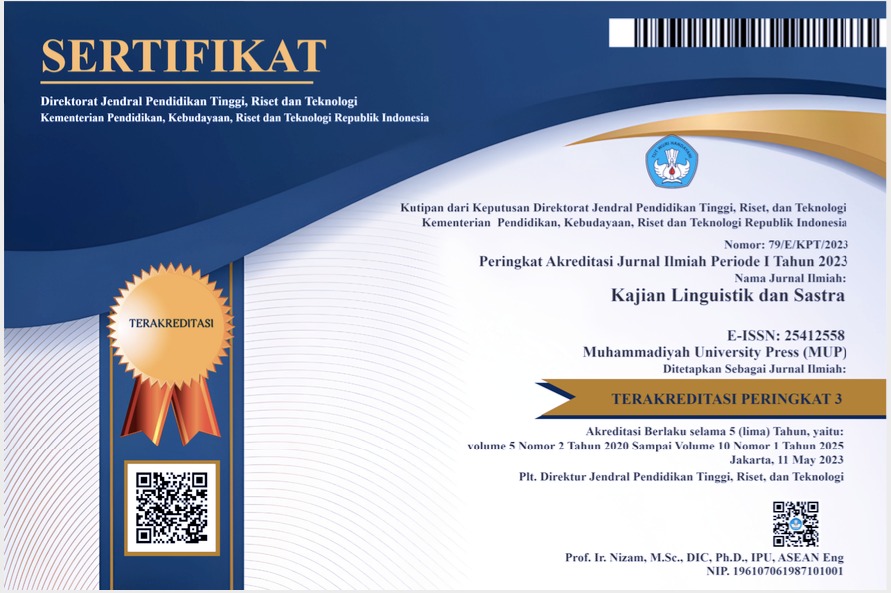Shapeshifting in Social Spaces: Sociolinguistic Competence of Multilingual Learners
DOI:
https://doi.org/10.23917/kls.v9i2.6606Abstract
The study aims to determine the sociolinguistic competence level of the multilingual Grade 10 learners at Buhisan Night High School for the Academic Year 2024-2025. Terogo et al. (2018), stated that even though students have been shown to gain exceptional grades in English subjects, they fall short in sociolinguistic competence since it is not practiced more often in the Philippines. Thus, assessing sociolinguistic competence is important as well as addressing the low-level sociolinguistic competency of the learners through an action plan. A descriptive quantitative research method was used to determine the sociolinguistic competence level of the multilingual 48 student-respondents. The researcher adapted a TOIEC test and used a researcher-made questionnaire to assess the learners’ sociolinguistic competence. A weighted average mean was used to determine their proficiency and sociolinguistic competence level. Based on the results of the study, situational judgment got the highest rank while reading comprehension got the lowest rank in terms of the learners’ proficiency level. However, the study revealed that the respondents got a general weighted average of 15.83 which means that the respondents’ sociolinguistic competence level is under “Basic Sociolinguistic Competence” which is below the passing rate with a percentage of 58.63. The study recommends enhancing students’ sociolinguistic competence through the integration of sociolinguistic competence in language teaching through enhancement activities and exercises such as role-playing, dialogues and situational exercises, and future researchers may use the findings as a basis for future research or conduct related studies to enhance the sociolinguistic competence of Filipino multilingual learners.
Downloads
References
S. Pinker, The Language Instinct: How the Mind Creates Language. London: Penguin UK, 2003.
N. Fariha, K. Anwar, and N. Maruf, “Exploring the Correlation of Sociolinguistic Competence and Speaking Proficiency, and How Learners Perceived Them,” English Rev. J. English Educ., vol. 11, no. 3, pp. 1001–1012, 2023, doi: 10.25134/erjee.v11i3.9083. DOI: https://doi.org/10.25134/erjee.v11i3.9083
L. Rebato, “Attitude Towards The Filipino Language And Communicative Competence Of Senior High School Students In Samar National School,” vol. 27, pp. 39–46, 2024.
I. J. R. Terogo, C. A. C. Elimino, J. P. M. Tallo, J. A. Sacal, and C. M. J. Balahadia, “Linguistic and Sociolinguistic Competence of Senior High School Students,” Philipp. E-Journal, vol. 6, no. 1, 2018, [Online]. Available: https://ejournals.ph/article.php?id=13079 DOI: https://doi.org/10.32871/rmrj1806.01.03
C. A. Mizne, “Teaching Sociolinguistic Competence in the ESL Classroom,” 1997. [Online]. Available: https://trace.tennessee.edu/cgi/viewcontent.cgi?article=1019&context=utk_interstp%092
D. Hymes, Fondations in Sociolinguistics: An Ethnographic Approach. Philadhelpia: University of Pennsylvania, 1974.
R. Nordquist, “The Definition of Sociolinguistics: The Relationship Between Language and Society.” [Online]. Available: https://www.thoughtco.com/sociolinguistics-definition-1692110
D. E. Freeman and Y. S. Freeman, Essential Linguistics: What You Need to Know to Teach Reading, ESL, Spelling, Phonics, and Grammar. Portsmouth, NH: Heinmann, 2004.
S. J. Savignon, “Communicative Competence,” TESOL Encycl. English Lang. Teach., pp. 1–7, 2017, doi: https://doi.org/10.1002/9781118784235.eelt0047. DOI: https://doi.org/10.1002/9781118784235.eelt0047
J. L. Martinez and P. V. De Vera, “Sociolinguistic Competence of Foreign National College Students,” Asian EFL J., vol. 21, no. 2, pp. 291–336, 2019, [Online]. Available: https://eric.ed.gov/?id=ED604155
N. Thi Thu Huong, L. Thi Thu Nga, and N. Thi Thu Huong Thai Nguyen, “Enhancing Communicative English Basing On Sociolinguistic Competence Of TUAF Students,” IOSR J. Res. Method Educ., vol. 10, no. 4, pp. 54–62, 2020, doi: 10.9790/7388-1004025462.
A. T. Nguyen and O. Nguyen, “The Impact of Sociolinguistic Factors on Learners’ Oral Communicative Competence,” 2020, [Online]. https://zienjournals.com/index.php/tjpch/article/view/5038
I. Siregar, “Epistemological Challenges Against Sociolinguistics,” Int. J. Linguist. Stud., vol. 1, no. 2, pp. 37–42, 2021, doi: 10.32996/ijls.2021.1.2.6. DOI: https://doi.org/10.32996/ijls.2021.1.2.6
J. J. J. Ureel, E. Diels, I. S. Robert, and I. Schrijver, “The Development of L2 Sociolinguistic Competence in Translation Trainees: an Accommodation-Based Longitudinal Study into The Acquisition of Sensitivity to Grammatical (in)Formality in English,” Interpret. Transl. Train., vol. 16, no. 1, pp. 78–95, 2022, doi: 10.1080/1750399X.2021.1900712. DOI: https://doi.org/10.1080/1750399X.2021.1900712
D. Subandowo, “A Detailed Overview on Sociolinguistic Competence in Pedagogical Applications,” Int. J. Humanit. Stud., vol. 5, no. 2, pp. 238–246, 2022, doi: 10.24071/ijhs.v5i2.4411. DOI: https://doi.org/10.24071/ijhs.v5i2.4411
R. R. Avila, “Sociolinguistic Competence, Linguistic Intelligence, and Self-Efficacy in Teaching Filipino: Input to Pedagogical Enhancement in National High Schools of Capiz,” Int. J. Arts, Sci. Educ., vol. 4, no. 2, pp. 233–243, 2023, [Online]. Available: https://www.mail.ijase.org/index.php/ijase/article/view/260










